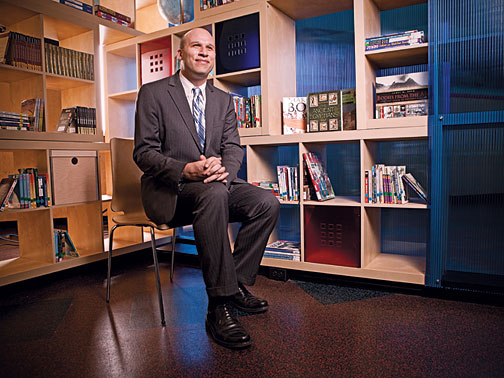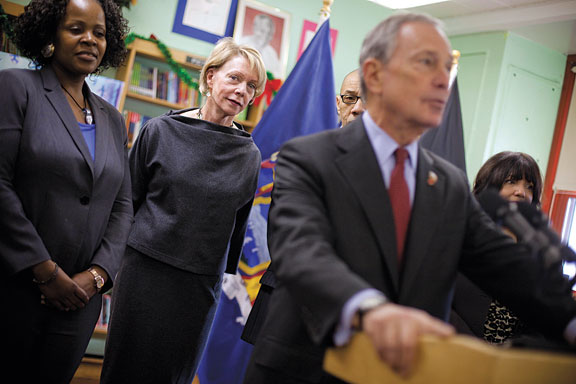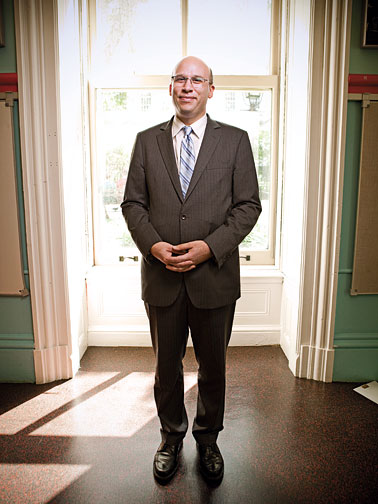It's the kind of meeting educators hate: a hundred angry parents packed into a stuffy school auditorium and squeezed into seats built for third-graders. This is Park Slope, Brooklyn, an enclave of urban, liberal-leaning professionals who push their babies around in $800 strollers while pondering whether or not the new artificial grass in the park will give their kids cancer. These parents obsess over every detail of their children's lives—especially their education.
And tonight they are angry.

"How can you use a tool to evaluate my child that has no validity?" one of them asks.
She is referring to the annual standardized tests the city uses to assess student performance, tests that are dreaded and loathed in Brooklyn at least as much as they are in the rest of the country. Parents everywhere complain they are a one-size-fits-all assessment that measures a student's ability by how well he or she answers multiple-choice questions.
"As a taxpayer," one mother says at the meeting, "they make me want to get violent."
Through it all, Polakow-Suransky remains calm and collected. The exams are by no means perfect, he says, but at the moment they are the best way the city has of ensuring that its schools offer a fundamentally sound education. Whereas schools were once evaluated solely on whether or not they taught the curriculum, they are now judged on how well they teach it. "We don't yet really have a strong, robust evaluation system," he concedes. But "at this moment in time they are the only tests available."
Shael Polakow-Suransky wants to change that. Long a champion of progressive education, he's an outsider turned insider, a revolutionary become reformer. In the schools where he's worked—the Crossroads Middle School and Bread and Roses Integrated Arts High School in upper Manhattan and the Bronx International High School—students called their teachers by their first names and received lengthy written evaluations instead of graded report cards. Yet here he is, the second-in-command of a school system that measures the success of its students with a standardized multiple-choice exam.
Few people are as determined as Polakow-Suransky to bring the lessons of progressive education into the public school systems of our major cities. His mission in New York City is to find a way to reconcile the free-form, experimental approach on which he's built his career with a system that depends strict, measurable systems of accountability. If he succeeds in reconciling an education philosophy he first learned at Brown with the rigid testing requirements of the No Child Left Behind Act of 2001, he will have created an approach that could serve as a new model for public schools across the entire country.
Polakow-Suransky owes his ascent to power in the NYC Department of Education to a political blunder. Last November, New York City mayor Michael Bloomberg announced he'd selected publishing executive Cathie Black to head the city's school system. Black, who had been president of Hearst Magazines since 1995—overseeing such titles as Esquire, Cosmopolitan, and O, The Oprah Magazine—had no background in education or government. In fact, it was reported she had set foot in a New York City public school only once.
State education officials, who had to approve the nomination, were not pleased. To ease their fears, the mayor proposed appointing Polakow-Suransky as Black's chief academic officer to firm up the Black administration's policy credentials. Mild-mannered and something of a policy wonk, Polakow-Suransky is unlike Black or the other hard-charging managers Bloomberg typically chooses for top positions. But Polakow-Suransky had achieved near-miraculous results as the principal of Bronx International High School, which serves some of the city's poorest children. Bloomberg suggested that Polakow-Suransky could tutor Black and fill in the gaps on her résumé.
Three months later, Black was out. Her autocratic style did not mesh well with the give-and-take of New York City politics, and she quickly alienated parents and teachers, especially after, in a public forum, she responded to a question about overcrowding in the schools—a serious problem in New York City that leaves students taking classes in trailers—with the quip: "Could we just have some birth control for a while?"

Promising a change in tone, Bloomberg named Dennis Walcott, a longtime aide, to replace Black. Polakow-Suransky remained in his position as chief academic officer and senior deputy chancellor. At the tender age of thirty-nine, he now finds himself one of the most powerful education officials in the country.
Polakow-Suransky's journey to New York City began in South Africa, where he was born. He did not live there long. His parents, Valerie Polakow and Leonard Suransky, were academics and anti-apartheid activists. Among other things, they taught literacy to blacks, reflecting the family's deep belief in the transformative power of education.
In 1973, when Shael was a year old, his parents learned that they might soon be arrested. Within days they were on their way to Ann Arbor, Michigan, where Polakow and Suransky had been accepted as graduate students. Shael and his younger brother, Sasha Polakow-Suransky '01, grew up living with their mother, an educational psychologist at Eastern Michigan University who studies the effects of poverty on women and children. The boys spent their summers with their father, who left the United States for South Africa in 1988. (He now works at Webster University in Holland.)
It was a family in which ideas mattered. "We argued a lot at dinner," says Sasha, a Rhodes Scholar and now a staff editor of the New York Times op-ed page. "It was a politicized upbringing." Dinner conversation centered on social justice, poverty, racism, and the distribution of wealth. Valerie says she also encouraged her children to participate in family decisions. "We had a very democratic family," she says. "Both boys were given a voice in issues affecting their lives."
The boys attended Community High School, an alternative school known around Ann Arbor as "Commie High." It was founded in the early 1970s by a group of teachers who insisted on only two rules: no smoking except in the teacher's lounge, and all persons must wear shoes. The school had become more mainstream by the time the Polakow-Suranskys got there, but students still called teachers by their first names, helped to design the curriculum, and received academic credit for working in the community, a requirement that has since become commonplace in many schools across the country. The student body at Community High was made up of outcasts, geeks, nerds, punks, and skateboarders, some of whom just happened to be the smartest kids in the city. Many university professors in the area sent their kids there as well.
"The stereotype was that everyone was smoking pot and skateboarding in the parking lot between classes," Sasha Polakow-Suransky says. "But we still managed to have some of the highest SAT scores in the state of Michigan." He says the vibe was "laid-back counterculture, sort of hippie."
The school had a lasting impact on Shael Polakow-Suransky. He says it showed him the value of small schools "in creating a personal, communal type of space" where teachers know their students well and can make sure none of the kids slip through the cracks. He also says Community High's "school without walls" approach, where students got credit for doing work in the real world, "taught me the power of hands-on learning. Kids need whenever possible to get out into the community."
Polakow-Suransky spent one semester of his senior year at Community High living in South Africa with his father. He earned academic credit by tutoring math at a high school founded by the United States Agency for International Development for black students who had been kicked out of their own schools for political activism. When the students weren't working on the usual high school courses, they organized anti-apartheid activities and protests. Polakow-Suransky says he got to see firsthand "how a school can foster outside social reform." This remains for him one of the most important things schools can do.
It was no surprise, then, that Polakow-Suransky arrived at Brown knowing he wanted to concentrate in education. He naturally gravitated to Professor of Education Ted Sizer, who was one of the most prominent educators in the country. (Sizer died in 2009.) About a decade earlier, Sizer had set up the Coalition of Essential Schools (CES)—a collection of roughly one dozen experimental schools that shared his commitment to progressive education. (CES now has hundreds of schools as members.) Sizer thought schools should build moral character as well as instill knowledge. The curriculum should be designed around an individual student's needs, strengths, and weaknesses rather than imposed from above as one-size-fits-all.
At CES schools, students probed a few topics deeply rather than trying to survey an entire period of history or teach all the fundamentals of chemistry. Kids and teachers participated as equals in trying to answer what Sizer called the "essential questions," those that explored fundamental human values and issues of identity, such as "Who am I?" or "How do we know what we know?" Sizer's approach appealed to Polakow-Suransky, he says, because it was "policy work that was having a real impact."
For his senior thesis—Sizer was his adviser—Polakow-Suransky compared the South African school in which he'd volunteered with the Providence-based group Direct Action for Rights and Equality, which fights for greater access to public education. Again, Polakow-Suransky focused on the role of schools in transforming society, or, as he describes it, "How do you use an educational process to shape a process of change?" He says in South Africa the skills and values instilled in students led to a profound sense of mutual responsibility. They learned to offer one another help on everything from finding a lawyer to finding temporary shelter.
The students there also took what they learned in school and applied it in the larger community, raising consciousness about apartheid's evils. "One of the most powerful things that schools can do," Polakow-Suransky says, "is create a sense of agency and capacity, really giving kids what they need to be active citizens."
After graduating from Brown, Polakow-Suransky taught at Crossroads Middle School in Harlem, a progressive school offering an alternative to the neighborhood's mainstream junior highs. Sixth, seventh, and eighth graders learned together, and all could try to challenge their report cards at parent-teacher conferences.
"I loved teaching," Polakow-Suransky says. "It's definitely the hardest job I've ever had." Within a few years, Polakow-Suransky says he had found his voice and an understanding of teaching as the combination of three critical skills: using authority effectively, building relationships with students, and carefully planning lessons beforehand.
At Crossroads, Polakow-Suransky befriended another teacher, Carol Foresta, and they decided to create a new high school together. None of the kids at Crossroads had a good high school to go to when they left eighth grade, they thought. So why not create one?
The pair founded the Bread and Roses Integrated Arts High School, which opened in Harlem in 1997 with ninety-nine ninth graders and nine teachers, one of them Polakow-Suransky. Its students were poor, mostly from minority populations, and they often lagged well behind in literacy.

For instance, he and Foresta wanted to have no more than twenty students in each class, an unusually low number for New York City. This class size required more teachers, which in turn meant less money to hire administrative and support staff. As a result, the already overburdened teachers had to handle much of the bureaucratic paperwork as well. "You have to ask teachers to do a lot of extra work that isn't part of their jobs," Polakow-Suransky says. "It stresses them out and overwhelms them." He says there arose "tremendous conflict" at the school over who handled which responsibilities. Nevertheless, he says that Bread and Roses was a success—close to 70 percent of the students graduated—but "it was at a great cost of blood, sweat, and tears to the faculty."
After four years, Polakow-Suransky became assistant principal at Bread and Roses. A year later, he went off to found the Bronx International High School, which he led as principal. Bronx International admitted 400 low-income immigrants with limited English skills. Many of the students were refugees fleeing war, poverty, or environmental catastrophes. Polakow-Suransky could now finally implement as many of Sizer's ideas as he saw fit. Teachers were split into groups and assigned a small number of students. Students could talk about emotional or social problems in advisory groups. The curriculum was interdisciplinary. Teachers were even allowed to alter the time length of periods.
Polakow-Suransky says that as other new schools opened using this approach, officials in the education bureaucracy balked. They didn't feel his methods were acceptable. Polakow-Suransky was part of team that petitioned to create a district within a district, called Empowerment Schools, a designation made by the city education department that gave principals unprecedented freedom and autonomy. "Anything that doesn't violate federal and state law, you have flexibility on," Polakow-Suransky says. "In exchange, you have to prove that the kids are really learning."
Attendance at Bronx International rose to more than 90 percent. By 2006, the graduation rate had climbed to 72 percent, up from 54 percent only a few years before, and roughly three times the rate at other city schools serving similar immigrant populations.
Polakow-Suransky moved into central administration in 2004, working in the education department's office of new schools to train new school principals. His big break came in 2010, when he became deputy chancellor for performance and accountability. He was now in charge of overseeing the assessment and evaluation of more than 1,700 schools.
Unfortunately, Polakow-Suransky's life has not been without tragedy. Less than a year before Bloomberg tapped him for the number-two position, his wife, the gifted actor Brienin Bryant '94, died of breast cancer. The pair had met at a party in New York City. Bryant had landed roles in episodes of Oz, Law and Order, and Third Watch. She had also starred in several off-Broadway plays. On the website Vimeo, Polakow-Suransky posted a video of her at a gathering of friends, delivering a soliloquy from Chekhov's The Cherry Orchard. She is frail and in a wheelchair. "It was her way of saying goodbye to those she loved," Polakow-Suransky wrote on the caption beneath the video. "For those of us still learning to say goodbye to Brie, I hope it brings some comfort."
At the school meeting in Brooklyn, furious parents continue their complaints about the city's standardized tests. At the beginning of the meeting, Polakow-Suransky had said, "I'm eager to get to the meat of the conversation," and the crowd has wasted no time taking him up on the offer. There's so much pressure on kids to do well on the exams, one parent says, "it's making them throw up."
Since last year, Polakow-Suransky has been working with school officials from twenty-four states in a consortium called the Partnership for Assessment of Readiness for College and Careers. PARCC is devising a radical new system for evaluating math and reading skills. Its new exams still contain some multiple-choice questions, but most questions require essay writing, and to solve math problems students must show their calculations. In the essays, students must cite evidence to support their arguments, while the math questions refer to real-life applications of mathematical principles. The idea is that, although there are times when a correct answer is indeed the best way to judge learning, a test that probes more deeply is less prone to severely penalize a student for a minor mistake in addition, say, or for an unconventional, yet thoughtful, interpretation of a text.
The expectation is that the states participating in PARCC will adopt these reforms in time for the 2014-15 school year. The schools will use a new curriculum called the Common Core Standards, an approach that emphasizes depth rather than breadth—exactly what Ted Sizer was advocating at Brown. Instead of merely summarizing the content of reading samples, for example, students will have to write essays in which they identify main themes and present evidence to support their arguments. In a pilot New York City program, students in ninth and tenth grade studied the evolution of the Internet and then wrote 750-word essays on the questions "What are the dangers for the lives of young people?" and "What are the gains that come from new media?" Fourth graders studied the conservationist John Muir and then composed essays describing the effect of Muir's work on "preserving the beauty of nature."
Polakow-Suransky believes that the combination of Common Core Standards and PARCC exams will allow public school curricula and standardized tests to reflect the highest standards of critical thinking. Teaching to the test will no longer be a problem, he argues, because the test will be a more complicated and useful measuring stick. And Polakow-Suransky's own philosophy of education will no longer conflict with the standardized approaches he has to carry out as a city education department official.
Yet Polakow-Suransky believes we are only at the beginning of a new, more sophisticated educational approach. In politically sensitive school departments, change takes time. "You want the change to happen slowly," he says. "Otherwise, people become cynical and think you're just interested in doing it.
"We're interested in doing it well."
Lawrence Goodman is the BAM's senior writer.




